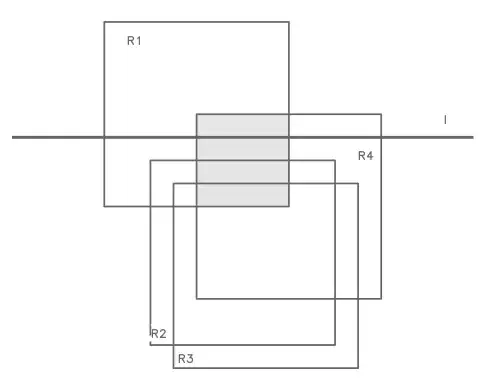Solving the given problem I tried different approaches, obtaining better and better bounds. Also the last bound is the best, I leave the other too, because they can help to solve similar problems.
Bound 4. I claim that $n\le 3$. Indeed, assume to the contrary, there exists a family $\mathcal R$ of $4$ (congruent) rectangles representing Venn diagram.
Define two orders $\le_x$ and $\le_y$ on $\mathcal R$. Namely, for rectangles $R,R’\in\mathcal R$ put $R\le_t R’$ if $t$-coordinate of the left side of the rectangle $R$ in not bigger that $t$-coordinate of the left side of the rectangle $R’$. Let $R_1\le_x R_2\le_x R_3\le_x R_4$ be the enumeration of the family $\mathcal R$.
Assume first that $R_1$ or $R_4$ is a minimal or a maximal element of $(\mathcal R,\le_y)$. Applying, if needed, to the plane transformations $x\mapsto -x$ and $y\mapsto -y$, without loss of generality we may suppose that $R_1$ is a minimal element of $(\mathcal R,\le_y)$. If $R_2\le_y R_4$ then $R_1\cap R_4\subset R_2$,
contradicting the property of Venn diagram. If $R_3\le_y R_4$ then $R_1\cap R_4\subset R_3$, contradicting the property of Venn diagram. Thus $R_4\le_y R_2$ and $R_4\le_y R_3$. Now if $R_2\le_y R_3$ then $R_1\cap R_3\subset R_2$, contradicting the property of Venn diagram and if $R_3\le_y R_2$ then $R_2\cap R_4\subset R_3$, contradicting the property of Venn diagram.
Thus in the order $\le_y$ the elements $R_1$ and $R_4$ are placed between elements $R_2$ and $R_3$. But then $R_1\cap R_4\subset R_2\cup R_3$, contradicting the property of Venn diagram. Indeed, assume to contrary that there is an (interior) point $R_1\cap R_4\setminus (R_2\cup R_3)$. Let $\ell$ be a horizontal straight line going through the point $x$. It is easy to see that if $\ell$ intersects any of rectangles $R_2$ or $R_3$ then it contradicts the choice of $R_1$ or $R_4$ as a leftmost or a rightmost rectangle. Since $R_2$ and $R_3$ intersects, both $R_2$ and $R_3$ lie above $\ell$ or both $R_2$ and $R_3$ lie below $\ell$, a contradiction with that $R_2$ and $R_3$ are topmost and bottommost rectangles.

Bound 3. I claim that $n\le 4$. Indeed, assume to the contrary, there exists a family $\mathcal R$ of $n\ge 5$ (congruent) rectangles representing Venn diagram. Define two orders $\le_x$ and $\le_y$ on $\mathcal R$. Namely, for rectangles $R,R’\in\mathcal R$ put $R\le_t R’$ if $t$-coordinate of the left side of the rectangle $R$ in not bigger that $t$-coordinate of the left side of the rectangle $R’$. By Erdős–Szekeres theorem there exist distinct rectangles $R,R’,R’’\in\mathcal R$ such that $R\le_x R’\le_x R’’$ and either $R\le_y R’\le_y R’’$ or $R’’\le_y R’\le_y R$. Anyway, $R\cap R’’\subset R’$, contradicting the property of Venn diagram.
Bound 2. A more tight upper bound for $n$ can be obtained as follows. Given a partition of the plane into domains by rectangles, consider corners of these domains as vertices of a graph $G$ and the segments of sides of rectangles connecting some of the corners as vertices of the graph. Then each of rectangles of the family contributes at most $4$ its corners to the total number $c$ of the corners, and each two different rectangles of the family additionally contribute to this number at most $4$ in the general case and at most $2$ in your case. Thus $c\le 4n+2n(n-1)=2n^2+2n$ in the general case and $c\le 4n+n(n-1)=n^2+3n$ vertices in your case.
Now double count a number $N$ of pairs $(e, f)$ where $e$ is a edge of the graph $G$ incident to its face $f$. Since, by the construction, each face $f$ of the graph $G$
has degree at least $4$, it contributes at least $4$ to the sum for $N$, implying $N\ge 4r$, where $r$ is the number of faces of the graph $G$, equal to the number of domains in which the rectangles partition the plane. On the other hand, each edge $e$ of $G$ is incident to exactly $2$ faces (we also count the outer face, if needed), so it contributes exactly $2$ to the sum for $N$, implying $N=2m$, where $m$ is the number of edges of the graph $G$. Thus $2m=N\ge 4r$.
Combining the obtained inequality with Euler’s formula $c-m+r=2$, we obtain $r=2+m-c\le m/2$, or $m+4\le 2c$. Then $r=2+m-c\le 2c-2-c=c-2$, which is at most
$2n^2+2n-2$ in the general case and at most $n^2+3n-2$ in your case.
The inequality $r\ge 2^n$ implies $n\le 6$ in the general case and $n\le 5$ in your case.
Bound 1. Even in a general case, when we do not require that the rectangles has the same width and height, the family consisting of $n$ rectangles span by their sizes at most $2n$ lines parallel to each of the coordinate axis. So they can partition the plane into at most $(2n+1)^2$ domains, whereas Venn’s diagram has $2^n$ domains. So $(2n+1)^2\ge 2^n$, which yields $n\le 8$.
